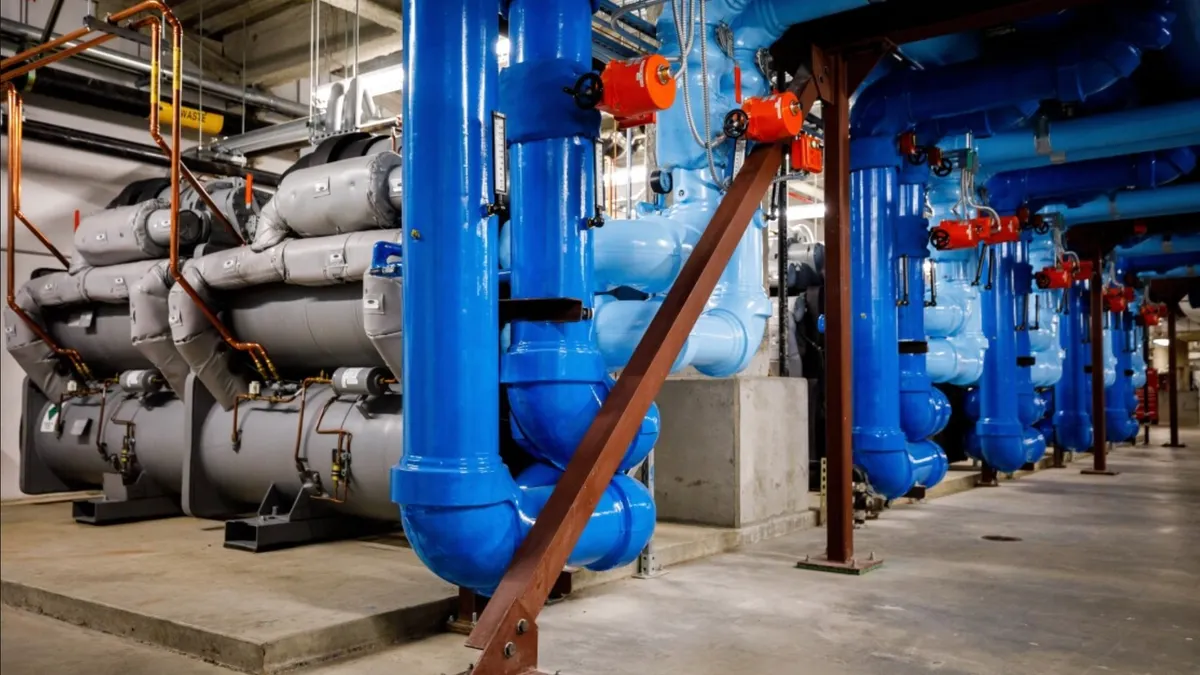Dive Brief:
- The rapid data center buildout is an opportunity for nearby facilities managers to make their own operations more efficient using the computing hubs’ waste heat, according to data center and district energy experts.
- The practice is already common in Europe, where urban district energy systems plug into data centers to pull heat off servers and provide efficient climate control for homes, businesses and campuses, Rob Thornton, president and CEO of the International District Energy Association, said in an interview.
- Data center heat recovery is less common in the U.S., but a nearly 10-year-old system that supplies heat to Amazon’s downtown Seattle campus highlights the potential in campus or dense urban environments, Thornton said.
Dive Insight:
The Seattle system pulls waste heat from a 34-story “carrier hotel” that serves hundreds of telecom and internet companies. The system then runs the waste heat through five heat-reclaiming chillers that heat water to about 130 degrees, according to Amazon.
The resulting hot water is potent enough that the 5 million square-foot campus rarely needs to use its backup boilers, Amazon said in 2017. The tech giant estimated the project will save 80 million kilowatt-hours of electricity and avoid 65 million pounds of carbon emissions over its 25-year service life.
A district energy system serving a suburban commercial district near Toronto also tapped an Equinix data center to provide space heat to “multiple residential buildings and a nearby hotel, hospital and local shopping center” and year-round hot water to “multiple buildings” in the area, Equinix Senior Manager of SustainabilityNoah Nkonge wrote in a blog post last year.
Equinix also supplies heat to a swimming pool built for the 2024 Paris Olympics and surrounding nearby buildings, according to Nkonge, who serves as heat export lead at Equinix.
“District energy systems have scale to assimilate and utilize large volumes of heat that would otherwise simply be rejected into the local environment as waste, sometimes exacerbating the heat island effect in cities,” Thornton said.
The heat expelled by data center cooling systems is much lower-grade than the heat coming off gas-fired boilers, so it generally needs to be concentrated in chiller systems like Amazon’s and may not be useful for industrial processes that require higher temperatures.
But institutional users increasingly see the opportunity to tap data centers in a more efficient, multi-source energy mix. Thornton pointed to a University of Virginia research park’s plans for a highly efficient energy plant that would utilize waste heat from a new data center to achieve a modeled coefficient of performance of nearly nine — about nine times the efficiency of a modern gas-fired boiler and double that of a typical ground-source heat pump’s.
Data center developers and operators recognize the opportunity as well, particularly as grid constraints drive a push for onsite power generation at new facilities. It just makes sense to do something useful with all that heat, Nkonge said at the International District Energy Association’s annual conference earlier this month.
“We want to export heat from our data centers wherever it is technically or economically feasible … not because we’re trying to create a new revenue stream, but because we think it’s the right thing to do to benefit the communities in which we operate,” Nkonge said.
Equinix’s Paris data center supplies heat to the Olympic district free of charge, Nkonge noted in the blog post.
Data centers will never see heat supply as their main business, but “it will be among the things that they do as a service or as an offset” as they strive to be more efficient, said Robert Montejo II, a Duane Morris partner who represents data center and renewable energy clients.
The AI data center construction boom is an opportunity to integrate heat recovery into facility design, particularly for “edge” data centers close to populated areas or industrial parks, Montejo said in an interview.
On the other hand, district-scale heat recovery may not be economical for rural data centers used for AI model training or other applications that can tolerate higher latencies, Montejo said. And the highly efficient liquid cooling systems favored by newer, more energy-intensive data centers may not recover as much useful heat, which could limit the scale of the opportunity, he said.












